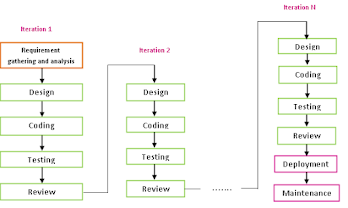The iterative model is a software development life cycle (SDLC) approach in which the initial development is started based on the initial requirements that are clearly defined and subsequent features are added to the base software product through iterations until the final system is completed.At each iteration, design modifications are made and new functional capabilities are added. The basic idea behind this method is to develop a system through repeated cycles (iterative) and in smaller portions at a time (incremental).
Unlike the more traditional waterfall model, which focuses on a step-by-step process of development stages, the iterative model is best thought of as a cyclical process.
An iterative life cycle model does not attempt to start with a full specification of requirements. Instead, development begins by specifying and implementing just part of the software, which is then reviewed to identify further requirements. This process is then repeated, producing a new version of the software at the end of each iteration of the model. It is specifically designed to start with the bare minimum requirements and only construct a portion of the program iteratively.
In this model, we can start with some of the software specifications and develop the first version of the software. After the first version if there is a need to change the software, then a new version of the software is created with a new iteration. It will repeat until deployment of the software.

Thanks for sharing. I read many of your blog posts, cool, your blog is very good.